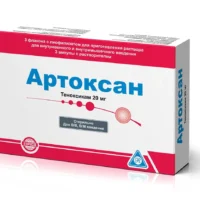Description
Fleccerin (Diacerein) Capsules 50 mg. №30
Ingredients:
Each capsule contains 50 mg of diacerein as the active ingredient.
Mechanism of Action:
Diacerein exerts its pharmacological effects by inhibiting interleukin-1 beta, a pro-inflammatory cytokine involved in the pathogenesis of osteoarthritis. By reducing the levels of interleukin-1 beta, diacerein helps to decrease inflammation and protect the cartilage in the joints, leading to improved symptoms and joint function.
Pharmacological Properties:
Diacerein is a slow-acting drug that belongs to the class of anthraquinone derivatives. It acts as an inhibitor of interleukin-1 beta, thereby reducing inflammation and preserving joint integrity in osteoarthritis.
Indications for Use:
Fleccerin capsules are indicated for the treatment of osteoarthritis to reduce pain, improve joint function, and slow down the progression of the disease.
Contraindications:
Do not use Fleccerin capsules if you are pregnant, breastfeeding, or have a history of allergic reactions to diacerein. Consult your healthcare provider before starting treatment.
Side Effects:
Common side effects of Fleccerin capsules may include gastrointestinal disturbances such as diarrhea, abdominal pain, and nausea. In some cases, allergic reactions like skin rash or itching may occur. If you experience severe side effects, discontinue use and seek medical attention.
Usage Instructions:
The recommended dosage is one 50 mg capsule taken orally once daily with food. Swallow the capsule whole with a full glass of water. Do not crush or chew the capsule.
Benefits Compared to Analogues:
Compared to other treatments for osteoarthritis, Fleccerin capsules offer the advantage of targeting interleukin-1 beta specifically, providing a more focused approach to reducing inflammation and preserving joint function.
Suitable Patient Groups:
Fleccerin capsules are suitable for adult patients with osteoarthritis. The dosage may need adjustment in elderly patients or those with renal impairment. Consult a healthcare professional for personalized recommendations.
Storage Conditions and Shelf Life:
Store Fleccerin capsules in a cool, dry place away from direct sunlight. Keep the medication out of reach of children. Check the expiration date on the packaging and do not use the capsules if expired.
Packaging Description:
Fleccerin capsules are available in a pack of 30 capsules. Each capsule is individually sealed for freshness and labeled with the product name and dosage strength.
Scientific Evidence:
Diacerein, the active ingredient in Fleccerin capsules, has been extensively studied for its efficacy in the treatment of osteoarthritis. Research has shown that diacerein helps to reduce pain, improve joint function, and slow down the progression of the disease. A study published in the International Journal of Rheumatic Diseases demonstrated that diacerein was well-tolerated and effective in improving symptoms of osteoarthritis over a 24-week period.





